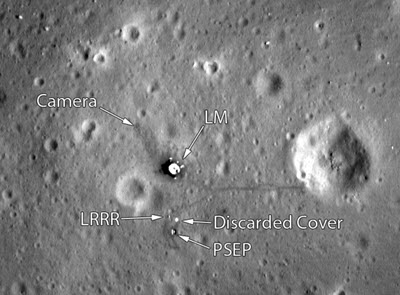 |
Jack Ganssle's Blog This is Jack's outlet for thoughts about designing and programming embedded systems. It's a complement to my bi-weekly newsletter The Embedded Muse.
Contact me at jack@ganssle.com. I'm an old-timer engineer who still finds the field endlessly fascinating (bio).
This is Jack's outlet for thoughts about designing and programming embedded systems. It's a complement to my bi-weekly newsletter The Embedded Muse.
Contact me at jack@ganssle.com. I'm an old-timer engineer who still finds the field endlessly fascinating (bio). |
We Shoot For The Moon
April 7, 2019
We were in Vero Beach last week tending to an ailing relative. A bit of spare time appeared so I ducked into the local Books-A-Million where I serendipitously came across Shoot For The Moon, by James Donovan. This new (2019) book is the story of the Apollo 11 landing. At almost 400 pages it's a deep and excellent look at the work done to get us to the moon.
The book starts off in the 1940s with Operation Paperclip, a frantic drive by American forces at the end of WWII to round up German rocket scientists (actually, engineers and technicians) and a trainload (literally) of V-2 parts and drawings. These folks were shepherded off to the Western States where they launched a number of V-2s under the auspices of the US army. Wernher von Braun (Michael Neufeld's Von Braun is a 500+ page excellent bio of this man) is depicted as a somewhat scheming self-promoter who even got Disney to memorialize him in the movie We Aim for the Stars. One comic noted that they sometimes hit London. Donovan does a good job of showing that Von Braun's role was not the father of Apollo, as many think, but rather as the brilliant leader of the Saturn rockets. Donovan makes it repeatedly clear he's disdainful of the man due to his Nazi affiliations and use of slave labor.
Enter the late 50s. The Soviets launched the, at the time, massive 184 pound Sputnik. Then they lofted the 1100 pound Sputnik 2 with a dog aboard.
Here in the US we repeatedly launched spectacular fireballs. Vanguard failed time and again. Von Braun's team was finally given permission to use their Jupiter-C to put the diminutive Explorer 1 (31 pounds) into orbit.
The book traces the space race which the Soviets dominated for the first years. Yuri Gagarin orbited; weeks later we were only able to pop Shepard into a low, ballistic boost.
Donovan traces each Mercury and Gemini flight with a background patois of the Soviet program growing fainter. Armstrong's Gemini 8 abort gets a lot of coverage as that set the tone for his later being chosen to command Apollo 11.
This might be the most detailed description of the actual landing in any popular book. It's riveting. A surprising amount of attention is paid to Steve Bales, the young flight controller who gave the "we're go" signal at each of the 1202 and 1201 alarms. Donovan calls the Apollo Guidance Computer the "first embedded computer," which might be true. It's nice to see a reference to "embedded" in the popular press!

A 2012 picture from the Lunar Reconnaissance Orbiter of the Apollo 11 landing site and the LM descent stage
There are a surprising number of small errors throughout the book. For example, Donovan calls liquid oxygen the "fuel" (it was the oxidizer; kerosene, hydrogen and the like were the fuels), and states Mercury's retro-pack was to reduce astronaut g-loads during reentry. He calls the Monroe doctrine "the policy stating that if any nation fired a missile in the Western Hemisphere, it would be considered and act of war against the United States." I doubt James Monroe, who died in 1831, thought much about guided missiles.
He states that the Apollo 10 LM, which was an all-up mission where the LM descended to 50,000 feet above the moon, had half-full tanks as NASA bosses were worried Stafford would otherwise attempt a landing, against mission rules. I have no data about this, but that level of insubordination seems awfully unlikely. If I distrusted my employees so much, I'd fire them.
The book is eminently readable, though not lyrical like Mike Collin's Carrying the Fire, the best of the Apollo astronauts' books. You won't get deep techie details about the hardware; this is the story of the men, and to a lesser extent, the machines that flew, and some that didn't.
Recommended.
It will soon be 50 years since this mission, and a lot of Apollo stories are coming out. By all means, do watch the movie Apollo 11, reviewed here.
Feel free to email me with comments.
Back to Jack's blog index page.
If you'd like to post a comment without logging in, click in the "Name" box under "Or sign up with Disqus" and click on "I'd rather post as a guest."
Recent blog postings:
- Non Compos Mentis - Thoughts on dementia.
- Solution to the Automotive Chip Shortage - why use an MCU when a Core I7 would work?
- The WIRECARE - A nice circuit tester
- Marvelous Magnetic Machines - A cool book about making motors
- Over-Reliance on GPS - It's a great system but is a single point of failure
- Spies in Our Email - Email abuse from our trusted friends
- A Canticle for Leibowitz - One of my favorite books.
- A 72123 beats per minute heart rate - Is it possible?
- Networking Did Not Start With The IoT! - Despite what the marketing folks claim
- In-Circuit Emulators - Does anyone remember ICEs?
- My GP-8E Computer - About my first (working!) computer
- Humility - On The Death of Expertise and what this means for engineering
- On Checklists - Relying on memory is a fool's errand. Effective people use checklists.
- Why Does Software Cost So Much? - An exploration of this nagging question.
- Is the Future All Linux and Raspberry Pi? - Will we stop slinging bits and diddling registers?
- Will Coronavirus Spell the End of Open Offices - How can we continue to work in these sorts of conditions?
- Problems in Ramping Up Ventilator Production - It's not as easy as some think.
- Lessons from a Failure - what we can learn when a car wash goes wrong.
- Life in the Time of Coronavirus - how are you faring?
- Superintelligence - A review of Nick Bostrom's book on AI.
- A Lack of Forethought - Y2K redux
- How Projects Get Out of Control - Think requirements churn is only for software?
- 2019's Most Important Lesson. The 737 Max disasters should teach us one lesson.
- On Retiring - It's not quite that time, but slowing down makes sense. For me.
- On Discipline - The one thing I think many teams need...
- Data Seems to Have No Value - At least, that's the way people treat it.
- Apollo 11 and Navigation - In 1969 the astronauts used a sextant. Some of us still do.
- Definitions Part 2 - More fun definitions of embedded systems terms.
- Definitions - A list of (funny) definitions of embedded systems terms.
- On Meta-Politics - Where has thoughtful discourse gone?
- Millennials and Tools - It seems that many millennials are unable to fix anything.
- Crappy Tech Journalism - The trade press is suffering from so much cost-cutting that it does a poor job of educating engineers.
- Tech and Us - I worry that our technology is more than our human nature can manage.
- On Cataracts - Cataract surgery isn't as awful as it sounds.
- Can AI Replace Firmware - A thought: instead of writing code, is the future training AIs?
- Customer non-Support - How to tick off your customers in one easy lesson.
- Learn to Code in 3 Weeks! - Firmware is not simply about coding.
- We Shoot For The Moon - a new and interesting book about the Apollo moon program.
- On Expert Witness Work - Expert work is fascinating but can be quite the hassle.
- Married To The Team - Working in a team is a lot like marriage.
- Will We Ever Get Quantum Computers - Despite the hype, some feel quantum computing may never be practical.
- Apollo 11, The Movie - A review of a great new movie.
- Goto Considered Necessary - Edsger Dijkstra recants on his seminal paper
- GPS Will Fail - In April GPS will have its own Y2K problem. Unbelievable.
- LIDAR in Cars - Really? - Maybe there are better ideas.
- Why Did You Become an Engineer? - This is the best career ever.
- Software Process Improvement for Firmware - What goes on in an SPI audit?
- 50 Years of Ham Radio - 2019 marks 50 years of ham radio for me.
- Medical Device Lawsuits - They're on the rise, and firmware is part of the problem.
- A retrospective on 2018 - My marketing data for 2018, including web traffic and TEM information.
- Remembering Circuit Theory - Electronics is fun, and reviewing a textbook is pretty interesting.
- R vs D - Too many of us conflate research and development
- Engineer or Scientist? - Which are you? John Q. Public has a hard time telling the difference.
- A New, Low-Tech, Use for Computers - I never would have imagined this use for computers.
- NASA's Lost Software Engineering Lessons - Lessons learned, lessons lost.
- The Cost of Firmware - A Scary Story! - A hallowean story to terrify.
- A Review of First Man, the Movie - The book was great. The movie? Nope.
- A Review of The Overstory - One of the most remarkable novels I've read in a long time.
- What I Learned About Successful Consulting - Lessons learned about successful consulting.
- Low Power Mischief - Ultra-low power systems are trickier to design than most realize.
- Thoughts on Firmware Seminars - Better Firmware Faster resonates with a lot of people.
- On Evil - The Internet has brought the worst out in many.
- My Toothbrush has Modes - What! A lousy toothbrush has a UI?
- Review of SUNBURST and LUMINARY: An Apollo Memoir - A good book about the LM's code.
- Fun With Transmission Lines - Generating a step with no electronics.
- On N-Version Programming - Can we improve reliability through redundancy? Maybe not.
- On USB v. Bench Scopes - USB scopes are nice, but I'll stick with bench models.

